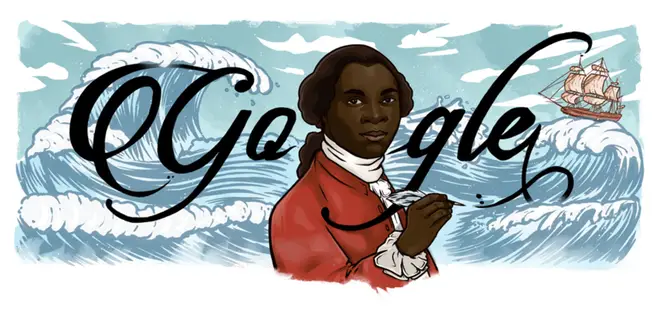On Air Now
Relaxing Evenings with Zeb Soanes 7pm - 10pm
1 October 2020, 16:32 | Updated: 20 June 2022, 11:39

Today’s Google Doodle depicts an extraordinary Black British composer, abolitionist and celebrated “man of letters” – here’s to the memory of Ignatius Sancho.
On the first day of Black History Month in the UK, a Google Doodle celebrates the life and work of Ignatius Sancho, a British composer and writer who fought for the equality and freedoms of people of African heritage.
Today’s Doodle, designed by UK-based artist, Kingsley Nebechi, shows Sancho holding a quill – although some have since queried whether Nebechi erroneously based his design on Black abolitionist Olaudah Equiano. His birthplace, a slave ship, is depicted the background.
Sancho, born around the year 1729, was the first Briton of African descent known to have been eligible and voted in a British general election, and to have an obituary published in the British press.
An acclaimed “man of letters”, Sancho wrote extensively about the abolition of slavery.
He is also credited as the first composer of African descent to publish music in the European tradition. Here’s all you need to know about his extraordinary life.
Read more: 9 black composers who changed the course of classical music history >

Charles Ignatius Sancho was born on a slave ship, c.1729. He was a slave for the first few years of his life on the Caribbean island of Grenada.
After his mother died of a disease, Sancho’s father killed himself – and the young boy was taken to England. There, he was once again forced to serve as a slave, for three sisters in Greenwich. As an adult, Sancho wrote: ‘the first part of my life was rather unlucky, as I was placed in a family who judged ignorance the best and only security for obedience’.
Fortunately, Sancho fell into the company of an aristocratic neighbour, John 2nd Duke of Montagu, who encouraged the young man to educate himself. The Duke gave him books to read, through which Sancho taught himself to read and write.
After the Duke’s death, he persuaded his widow to employ him. He became the Duchess’ butler in Montague House, Greenwich, where he stayed for two decades. Today, there is a plaque outside dedicated to Sancho’s name.
Having educated himself, Sancho started writing letters, criticising what he saw in 18th-century society and politics. His eloquent calls for the abolition of slavery were published by newspapers. For many readers, this was their first exposure to writing by a Black person. For British abolitionists, he became a symbol of the immorality of the slave trade.
Sancho became a celebrated cultural figure in London. He had taught himself to write music, and published four books of songs and lively dance music, including a Theory of Music and a collection of Minuets, Cotillons & Country Dances.
Today, he is credited as the first composer of African descent to publish music in the European tradition.
Read more: 19 black musicians who have shaped the classical music world >

Ignatius Sancho Minuets
Sancho married a West Indian woman, Anne Osborne, with whom he opened a greengrocer in Westminster. They had seven children: Frances Joanna, Ann Alice, Elizabeth Bruce, Jonathan William, Lydia, Katherine Margaret, and William Leach Osborne, three of whom didn’t survive past childhood.
As a financially independent male homeowner, Sancho was qualified to vote, a right he historically exercised in 1774.
The Letters of the Late Ignatius Sancho, an African – one of the earliest accounts of African slavery, written in English by a former enslaved person – were published posthumously in 1782. They gained wide readership and attention for the Slave Trade Act, which was made law in 1807.
Ignatius Sancho died from the effects of gout on 14 December 1780, and was buried at St Margaret’s Westminster. Today there is no memorial in the churchyard, but we remember him for his eloquent writings, beautiful music – and incredible courage to fight for the freedoms he knew were fair.
On creating his Doodle, artist Nebechi said: “I hope the Doodle can spark curiosity in people so they can research Ignatius and other essential Black figures in history. It’s hard to know where you are headed if you don’t know where you’re from.”
Unfortunately, Google has since faced criticism for appearing to have erroneously based their Doodle on another Black abolitionist, Equiano Olaudah, who played an essential role in helping to end the slave trade.
.@Google it's not a great start to mix up Black people to celebrate #BlackHistoryMonth on your home page.
— Dr Shola Mos-Shogbamimu (@SholaMos1) October 1, 2020
You've used the picture of Equiano Olaudah for #IgnatiusSancho.
Can't you tell the difference? I'm not impressed. pic.twitter.com/I2wJocqnem
Lawyer and women’s rights activist Dr Shola Mos-Shogbamimu tweeted about the mishap, saying: “Google, it’s not a great start to mix up Black people to celebrate Black History Month on your home page. You’ve used the picture of Equiano Olaudah for Ignatius Sancho. Can’t you tell the difference? I’m not impressed.”